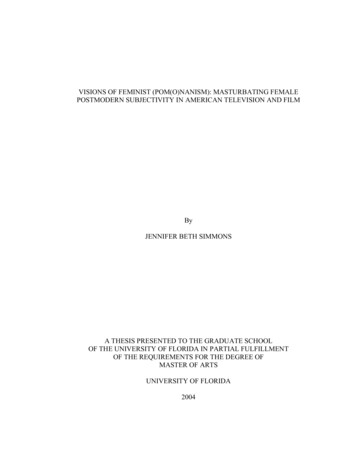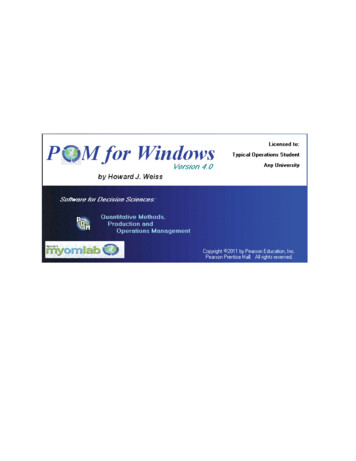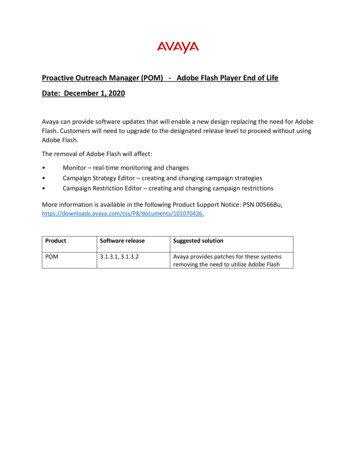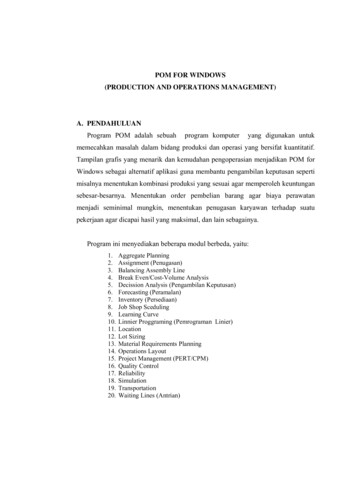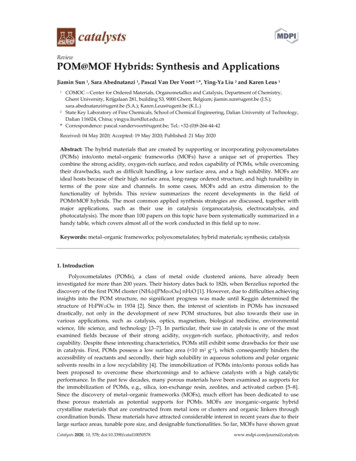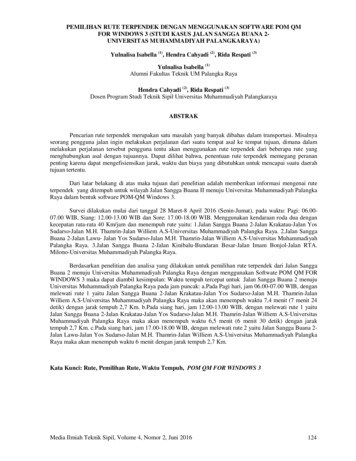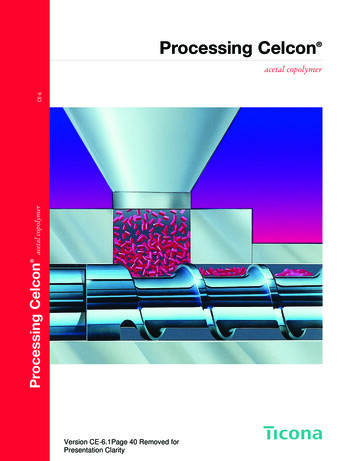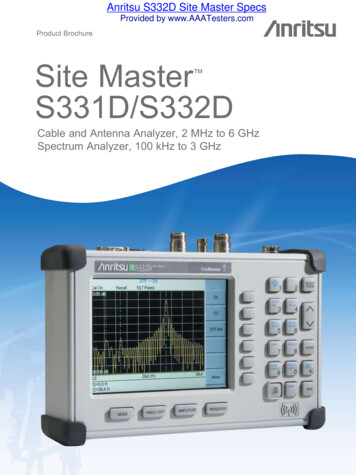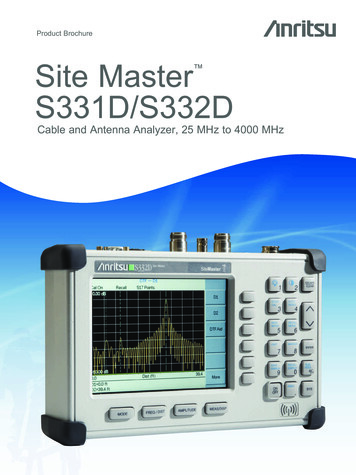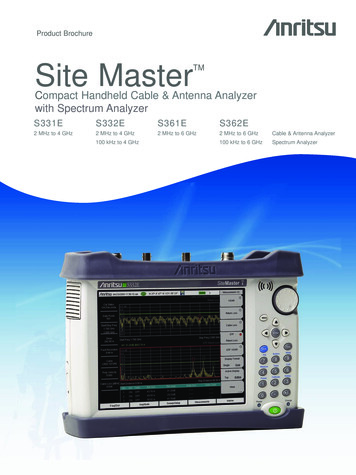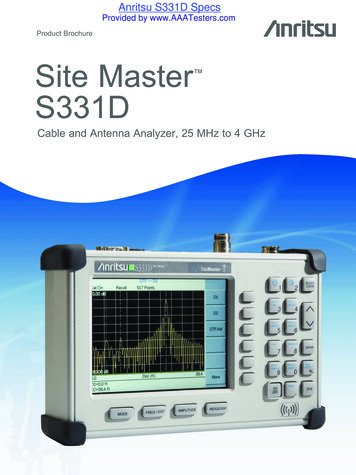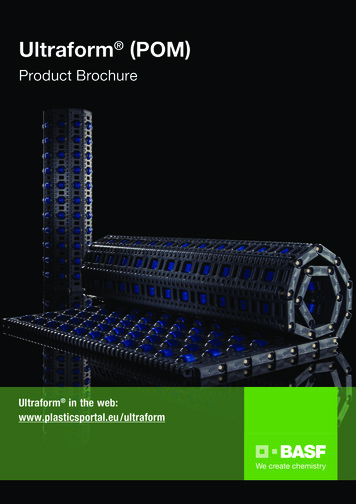
Transcription
Ultraform (POM)Product BrochureUltraform in the web:www.plasticsportal.eu /ultraform
Ultraform (POM)is the trade name for BASF’s product line of thermoplastically processable copolymeric polyoxymethylenes. The Ultraform family encompasses engineeringplastics with different characteristics suitable for usein complex and highly durable components.Ultraform meets the requirements made of a technical material especially well. It combines high stiffnessand strength with outstanding resilience, favorablesliding friction behavior and excellent dimensionalstability, even under the effect of mechanical forces,in contact with numerous chemicals, fuels and othermedia as well as at elevated temperatures.
Ultraform (POM)Ultraform in automotive construction4 - 5Ultraform for home and recreation6 -7Ultraform in industrial applications and medical technology8-910 - 21The properties of Ultraform Mechanical propertiesThermal propertiesBehavior on exposure to light and weatherResistance to water, fuels and chemicalsSterilizationBehavior on exposure to high-energy radiationFire behaviorElectrical propertiesProduct line101617182020202020General notesCompatibility with other thermoplasticsInjection moldingExtrusionFabrication and finishing processes2223243236Safety notesDelivery and storage(Integrated) management systemNomenclatureSubject index383939404122 - 37The processing of Ultraform 38 - 42General information
4Ultraform in automotive constructionUltraform in automotive constructionUltraform gives designers an engineering plastic that showsmany of the properties required in the automotive industry.Ultraform offers excellent fuel and chemical resistance, lowswelling, good long-term thermal stability and electricalinsulation capacity.Fuel tank moduleUltraform has long been successfully used in numerousapplications in the automotive industry, for instance, in the fuel system for tank caps, in components of fuelcarrying modules (flanges, fuel pumps, filter housings,swirl pots), for level gauges, in tank venting systems (rollover valves) for the steering and controls of torque roll restrictors, ballcups and ball bearings, levers, linkages, sensor components in the interior for loudspeaker grids, clips, fastening andspring elements, pushbuttons, deflection fittings andmechanical parts in safety belts in doors and windows, for example, for components toraise and lower windows and for the cranks of slidingsunroofs in the exterior, for clips and elements for fastening add-onparts, for windshield wiper clips, windshield washer nozzles,electro-mechanical adjustment mechanisms for mirrorsand headlights in the engine compartment for clips located away fromthe engine and for fastening elements in the electrical & electronic area for clips, fasteningelements and plug-in connectors.Liquid trap
Ultraform in automotive constructionMirror adjustment mechanismRoll-over valveLoudspeaker grills5
6Ultraform for home and recreationUltraform for home and recreationUltraform has been showing what it is made of for manyyears, also in the household and recreation realms. Thanksto its outstanding mechanical properties at elevated temperatures and its superior resistance to hot water, Ultraform has stood the test in millions of espresso and coffee-makingmachines.Other applications: parts of plumbing fixtures and inserts for showerheads components in watering and irrigation systems gas meters sliding and fastening parts for curtains functional parts in the hardware of doors and windows clasps, clips and fastening elements in sports andrecreation zippers shock-absorbing elements in washing machines functional parts and inserts in dishwashers components in vacuum cleaners tablet dispensers functional parts in toys: springs, clamps, gear wheels,motor and gear modules, sliding elements functional parts in furniture joints and drawer runnersGas meter housingBrewing unitSprinkler nozzle
Ultraform for home and recreationToy truckShower headToilet flushSpring clip7
8Ultraform in industrial applications and medical technologyUltraform in industrialand medical applicationsOwing to its extremely versatile and tailor-made propertiesas well as its high reliability even under demanding conditions, Ultraform is used in numerous industrial applications.Applications for machine and plant construction as wellas precision engineering: Fastening elements, ball bearings and roller bearings, gear wheels, gear parts, valves,impellers, deflection rollers, thread guides for textilemachines, links and connecting elements in conveyorchains and belts.The grade Ultraform PRO is adapted specifically for therequirements and needs of the medical industry. The suffix PRO (Profile Covered Raw Materials Only) expressesthat only very specific raw materials that are subject tostrict controls are used, and points to an expanded servicepackage for medical technology, also including formulationconsistency.Ultraform PRO is ideal for use with functional componentssuch as valves, springs, gears and snap-in mechanisms.Furthermore, for guiding and sliding elements which areused in various substance contributor systems, for examplein insulin pens, inhalers, auto-injectors and dispensers.Skin stretcherSemi-finished parts
Ultraform in industrial applications and medical technologyImplantation aidFunctional partsConveyor beltConveyor belt part9
10The properties of Ultraform Mechanical propertiesThe properties of Ultraform In view of its property profile, Ultraform belongs to theengineering plastics. It can be thermoplastically processedand has a partially crystalline structure with a high degree ofcrystallization. Ultraform is produced by the copolymerizationof trioxan and another monomer. It consists of linear chainsin which the co-monomers are firmly incorporated in astatistically distributed manner. These co-monomer unitsaccount for the high stability of Ultraform during processingand when exposed to long-term heat and to chemicals. Itsurpasses by far the resistance of homopolymeric polyoxymethylene.Ultraform absorbs very little water: approx. 0.2 % undernormal conditions ( DIN EN ISO 291) and only approx.0.8 % on complete saturation with water at 23 C. Its physical properties are so slightly affected by this that it is of littleimportance for practical purposes.The mechanical properties can be widely varied by employingsuitable elastomeric additives, mineral fillers and glass fibers.Elastomer-modified Ultraform grades largely retain theirPOM-like properties but exhibit a substantially higher level ofimpact resistance and a higher energy absorption capacity.Depending on the degree of modification, the rigidity andhardness of these grades is reduced.Mechanical propertiesThe special aspect of Ultraform is its ideal combinationof strength, stiffness and toughness, all of which can beascribed to the structure of the product. Owing to its highcrystallinity, Ultraform is stiffer and stronger than otherengineering plastics, especially within the temperature rangefrom 50 C to 120 C. Ultraform does not undergo anytransitions between the low glass-transition temperatureof approximately -65 C and the melting temperature ofapproximately 170 C. This translates into relatively constantmechanical properties over a fairly wide temperature rangethat is very attractive from a technical point of view (Fig. 1). At room temperature, Ultraform has a pronounced yieldpoint at about 8 -12 % strain. Below this limit, Ultraform exhibits good resilience, even under repeated loading, andis therefore especially suitable for elastic elements.In addition, it has high creep strength and a low tendency tocreep (Fig. 2).This combination of characteristics in association with goodtribolo gical properties makes it very suitable for engineeringapplications.Mineral-filled and especially fiberglass-reinforced Ultraform grades, in contrast, exhibit increased strength, stiffness andhardness.Fig. 7 shows the impact strength versus rigidity for selectedgrades.Behavior under long-term static loadingThe tensile creep test in accordance with ISO 899 -1 and thestress relaxation test in accordance with DIN 53441 provideinformation about extension, mechanical strength and stressrelaxation behavior under sustained loading.The results are illustrated as creep modulus plots (Fig. 2)and creep curves (Fig. 3).
Elongation [%]Shear modulus [MPa]The properties of Ultraform Mechanical properties104115.030 MPa103Ultraform 20 MPa2.510210 MPa10-50050100150200250Temperature [ C]Creep modulus EC [MPa]Fig. 1: Shear modulus as a function of the temperature(measured according to ISO 6721)σ 25 MPaσ 30 MPaσ 40 MPa2000100020010102103104Duration [hours]Fig. 2: Creep modulus EC of Ultraform N2320 003 as afunction of loading duration (measured in accordance withISO 899-1 under standard climatic conditions, 23 C / 50 % r. h.) 500075001000012500Loading duration [hours]Fig. 3: Creep curves for Ultraform N2320 003 at 23 C,measured in accordance with ISO 899-13000σ 5 MPaσ 10 MPaσ 15 MPaσ 20 MPa2500
The properties of Ultraform Mechanical propertiesFigs. 4 and 5 show the isochronous stress-strain curves forstandard and glass-fiber reinforced Ultraform .The graphs reproduced here are just a selection from ourextensive collection of test results. Further values and diagrams for different temperature and atmospheric conditionscan either be obtained from the Ultra-Infopoint or from theplastics materials database “Campus” on the internet.Tensile stress [MPa]1235Test temperature: 23 C3025201h10 h102 h103 h104 h5 ·104 h105 h15Design data obtained from uniaxial tensile loading tests canalso be used to assess a material’s behavior under multiaxialloads.10The PC programs “Snaps”, “Screws” and “Beams” developed by BASF can be used for the analysis of constructionelements such as snap and screw connections and beamssubjected to flexural stresses500.51.01.52.02.53.03.54.0Elongation [%]Fig. 4: Isochronous stress-strain curves for Ultraform N2320 003, measured in accordance with ISO 899 -1Impact strengthParts made from Ultraform stay impact-resistant over a widerange of temperatures. Due to its very low glass transitiontemperature (about - 65 C) Ultraform still exhibits outstanding impact resistance and adequate notched impact resistance at temperatures as low as - 30 C.Impact-resistant grades with graduated modification areavailable for applications with high demands on toughness.Fig. 7 shows a plot of impact strength versus rigidity forthese and other grades. A substantial gain in impact strengthis obtained at the expense of a moderate loss in rigidity.Tensile stress [MPa]The creep strength values determined for pipes made fromUltraform reflect a multiaxial stress condition and the all round action of water (Fig. 6).70Test temperature: 23 C6050401h10 h102 h103 h104 h5 ·104 h105 h30201000.20.40.60.81.01.21.41.61.82.0Elongation [%]Fig. 5: Isochronous stress-strain curves for Ultraform N2200 G53, measured in accordance with ISO 899-1
The properties of Ultraform Mechanical properties13Hoop stress [MPa]1 year 10 years504023 C3060 C2095 C1000.1110100100010000100000Duration of loading [hours]Charpy notched impact strength [kJ/m2]Fig. 6: Creep strength of pipes made from Ultraform H4320at various temperatures, with water inside and outside2015ToyN2650 Z6N2640 E4N2650 Z4N2650 Z2N2640 E210N2200 G53H2320 006/N/S2320 0035S1320 003/0021H2320 0045N2310PN2200 G43N/S2320 003H4320W2320 003N2720 M63N2720 M210S2320 003/W2320 lus of elasticity [MPa]Fig. 7: Impact strength vs. stiffness for selected Ultraform grades
14The properties of Ultraform Mechanical propertiesBehavior under cyclic loads, flexural fatigue strengthEngineering parts are frequently subjected to stress bydynamic forces, especially alternating or cyclic loads, whichact periodically in the same manner on the structural part.The behavior of a material under such loads is determinedin fatigue tests in flat bending or rotating bending tests(DIN 50100) up to very high load-cycle rates. The results arepresented in what are known as Wöhler diagrams obtainedby plotting the applied stress against the load-cycle rateachieved in each case (Fig. 8).The flexural fatigue strength is defined as the stress level asample can withstand for at least 107 cycles.It can be gathered from the graph that in the case ofUltraform N2320 003 the stress remains practically constant above about 107 load cycles.When the test results are applied in practice, it has to betaken into account that at high load alternation frequencies,the workpieces may heat up considerably due to internalfriction. In such cases, just as at higher operating temperatures, lower flexural fatigue strength values have to beexpected.Tribological propertiesThe smooth, hard surface and highly crystalline structureof this material allow its application for functional partssubjected to sliding friction. Even in the case of solid friction only slight wear is to be expected at the coefficientsof sliding friction likely to be in operation. The co efficientof sliding friction of Ultraform becomes smaller as thesurface roughness of the paired material increases, butwear caused by sliding friction will increase.The special grades of Ultraform W2320 003 TR, N2310 P,N2770 K and N2720 M210 display a marked improvementin their sliding and abrasion behavior. N2720 M210 e xhibitsoptimal properties, even at elevated surface pressures orgreater roughness of the sliding counterpart. Generallyspeaking, N2310 P and N2770 K against steel and W2320003 TR against plastics are best suited for applications inprecision mechanics.Figure 9 shows the coefficient of sliding friction and the rateof wear due to sliding friction of Ultraform N2320 003 andN2310 P as a function of the average roughness height. Theproperties of Ultraform N2310 P prov
Ultraform (POM) is the trade name for BASF’s product line of thermo-plastically processable copolymeric polyoxymethyl- enes. The Ultraform family encompasses engineering plastics with different characteristics suitable for use in complex and highly durable components. Ultraform meets the requirements made of a techni-
